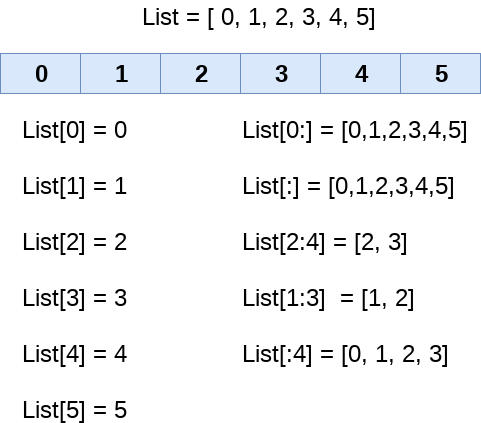TheDeveloperBlog.com
C-Sharp | Java | Python | Swift | GO | WPF | Ruby | Scala | F# | JavaScript | SQL | PHP | Angular | HTML
Python Lists
python lists - A simple and easy to learn tutorial on various python topics such as loops, strings, lists, dictionary, tuples, date, time, files, functions, modules, methods and exceptions.
Python ListA list in Python is used to store the sequence of various types of data. Python lists are mutable type its mean we can modify its element after it created. However, Python consists of six data-types that are capable to store the sequences, but the most common and reliable type is the list. A list can be defined as a collection of values or items of different types. The items in the list are separated with the comma (,) and enclosed with the square brackets []. A list can be define as below L1 = ["John", 102, "USA"] L2 = [1, 2, 3, 4, 5, 6] IIf we try to print the type of L1, L2, and L3 using type() function then it will come out to be a list. print(type(L1)) print(type(L2)) Output: <class 'list'> <class 'list'> Characteristics of ListsThe list has the following characteristics:
Let's check the first statement that lists are the ordered. a = [1,2,"Peter",4.50,"Ricky",5,6] b = [1,2,5,"Peter",4.50,"Ricky",6] a ==b Output: False Both lists have consisted of the same elements, but the second list changed the index position of the 5th element that violates the order of lists. When compare both lists it returns the false. Lists maintain the order of the element for the lifetime. That's why it is the ordered collection of objects. a = [1, 2,"Peter", 4.50,"Ricky",5, 6] b = [1, 2,"Peter", 4.50,"Ricky",5, 6] a == b Output: True Let's have a look at the list example in detail.
emp = ["John", 102, "USA"]
Dep1 = ["CS",10]
Dep2 = ["IT",11]
HOD_CS = [10,"Mr. Holding"]
HOD_IT = [11, "Mr. Bewon"]
print("printing employee data...")
print("Name : %s, ID: %d, Country: %s"%(emp[0],emp[1],emp[2]))
print("printing departments...")
print("Department 1:\nName: %s, ID: %d\nDepartment 2:\nName: %s, ID: %s"%(Dep1[0],Dep2[1],Dep2[0],Dep2[1]))
print("HOD Details ....")
print("CS HOD Name: %s, Id: %d"%(HOD_CS[1],HOD_CS[0]))
print("IT HOD Name: %s, Id: %d"%(HOD_IT[1],HOD_IT[0]))
print(type(emp),type(Dep1),type(Dep2),type(HOD_CS),type(HOD_IT))
Output: printing employee data... Name : John, ID: 102, Country: USA printing departments... Department 1: Name: CS, ID: 11 Department 2: Name: IT, ID: 11 HOD Details .... CS HOD Name: Mr. Holding, Id: 10 IT HOD Name: Mr. Bewon, Id: 11 <class 'list'> <class 'list'> <class 'list'> <class 'list'> <class 'list'> In the above example, we have created the lists which consist of the employee and department details and printed the corresponding details. Observe the above code to understand the concept of the list better. List indexing and splitting
The indexing is processed in the same way as it happens with the strings. The elements of the list can be accessed by using the slice operator []. The index starts from 0 and goes to length - 1. The first element of the list is stored at the 0th index, the second element of the list is stored at the 1st index, and so on. 
We can get the sub-list of the list using the following syntax. list_varible(start:stop:step)
Consider the following example: list = [1,2,3,4,5,6,7] print(list[0]) print(list[1]) print(list[2]) print(list[3]) # Slicing the elements print(list[0:6]) # By default the index value is 0 so its starts from the 0th element and go for index -1. print(list[:]) print(list[2:5]) print(list[1:6:2]) Output: 1 2 3 4 [1, 2, 3, 4, 5, 6] [1, 2, 3, 4, 5, 6, 7] [3, 4, 5] [2, 4, 6] Unlike other languages, Python provides the flexibility to use the negative indexing also. The negative indices are counted from the right. The last element (rightmost) of the list has the index -1; its adjacent left element is present at the index -2 and so on until the left-most elements are encountered. 
Let's have a look at the following example where we will use negative indexing to access the elements of the list. list = [1,2,3,4,5] print(list[-1]) print(list[-3:]) print(list[:-1]) print(list[-3:-1]) Output: 5 [3, 4, 5] [1, 2, 3, 4] [3, 4] As we discussed above, we can get an element by using negative indexing. In the above code, the first print statement returned the rightmost element of the list. The second print statement returned the sub-list, and so on. Updating List values
Lists are the most versatile data structures in Python since they are mutable, and their values can be updated by using the slice and assignment operator. Python also provides append() and insert() methods, which can be used to add values to the list. Consider the following example to update the values inside the list. list = [1, 2, 3, 4, 5, 6] print(list) # It will assign value to the value to the second index list[2] = 10 print(list) # Adding multiple-element list[1:3] = [89, 78] print(list) # It will add value at the end of the list list[-1] = 25 print(list) Output: [1, 2, 3, 4, 5, 6] [1, 2, 10, 4, 5, 6] [1, 89, 78, 4, 5, 6] [1, 89, 78, 4, 5, 25] The list elements can also be deleted by using the del keyword. Python also provides us the remove() method if we do not know which element is to be deleted from the list. Consider the following example to delete the list elements. list = [1, 2, 3, 4, 5, 6] print(list) # It will assign value to the value to second index list[2] = 10 print(list) # Adding multiple element list[1:3] = [89, 78] print(list) # It will add value at the end of the list list[-1] = 25 print(list) Output: [1, 2, 3, 4, 5, 6] [1, 2, 10, 4, 5, 6] [1, 89, 78, 4, 5, 6] [1, 89, 78, 4, 5, 25] Python List Operations
The concatenation (+) and repetition (*) operators work in the same way as they were working with the strings. Let's see how the list responds to various operators. Consider a Lists l1 = [1, 2, 3, 4], and l2 = [5, 6, 7, 8] to perform operation.
Iterating a ListA list can be iterated by using a for - in loop. A simple list containing four strings, which can be iterated as follows.
list = ["John", "David", "James", "Jonathan"]
for i in list:
# The i variable will iterate over the elements of the List and contains each element in each iteration.
print(i)
Output: John David James Jonathan Adding elements to the listPython provides append() function which is used to add an element to the list. However, the append() function can only add value to the end of the list. Consider the following example in which, we are taking the elements of the list from the user and printing the list on the console.
#Declaring the empty list
l =[]
#Number of elements will be entered by the user
n = int(input("Enter the number of elements in the list:"))
# for loop to take the input
for i in range(0,n):
# The input is taken from the user and added to the list as the item
l.append(input("Enter the item:"))
print("printing the list items..")
# traversal loop to print the list items
for i in l:
print(i, end = " ")
Output: Enter the number of elements in the list:5 Enter the item:25 Enter the item:46 Enter the item:12 Enter the item:75 Enter the item:42 printing the list items 25 46 12 75 42 Removing elements from the listPython provides the remove() function which is used to remove the element from the list. Consider the following example to understand this concept. Example -
list = [0,1,2,3,4]
print("printing original list: ");
for i in list:
print(i,end=" ")
list.remove(2)
print("\nprinting the list after the removal of first element...")
for i in list:
print(i,end=" ")
Output: printing original list: 0 1 2 3 4 printing the list after the removal of first element... 0 1 3 4 Python List Built-in functionsPython provides the following built-in functions, which can be used with the lists.
Let's have a look at the few list examples. Example: 1- Write the program to remove the duplicate element of the list.
list1 = [1,2,2,3,55,98,65,65,13,29]
# Declare an empty list that will store unique values
list2 = []
for i in list1:
if i not in list2:
list2.append(i)
print(list2)
Output: [1, 2, 3, 55, 98, 65, 13, 29] Example:2- Write a program to find the sum of the element in the list.
list1 = [3,4,5,9,10,12,24]
sum = 0
for i in list1:
sum = sum+i
print("The sum is:",sum)
Output: The sum is: 67 Example: 3- Write the program to find the lists consist of at least one common element.
list1 = [1,2,3,4,5,6]
list2 = [7,8,9,2,10]
for x in list1:
for y in list2:
if x == y:
print("The common element is:",x)
Output: The common element is: 2
Next TopicPython Tuples
|
Related Links:
- Python global and nonlocal
- Python not: If Not True
- Python Convert Decimal Binary Octal and Hexadecimal
- Python Tkinter Scale
- Python Tkinter Scrollbar
- Python Tkinter Text
- Python History
- Python Number: random, float and divmod
- Python Tkinter Toplevel
- Python Tkinter Spinbox
- Python Tkinter PanedWindow
- Python Tkinter LabelFrame
- Python Tkinter MessageBox
- Python Website Blocker
- Python Console Programs: Input and Print
- Python Display Calendar
- Python Check Number Odd or Even
- Python readline Example: Read Next Line
- Python Anagram Find Method
- Python Any: Any Versus All, List Performance
- Python Filename With Date Example (date.today)
- Python Find String: index and count
- Python filter (Lambda Removes From List or Range)
- Python ASCII Value of Character
- Python Sum Example
- Python make simple Calculator
- Python Add Two Matrices
- Python Multiply Two Matrices
- Python SyntaxError (invalid syntax)
- Python Transpose Matrix
- Python Remove Punctuation from String
- Python Dictionary items() method with Examples
- Python Dictionary keys() method with Examples
- Python Textwrap Wrap Example
- Python Dictionary popitem() method with Examples
- Python Dictionary pop() method with Examples
- Python HTML: HTMLParser, Read Markup
- Python Tkinter Tutorial
- Python Array Examples
- Python ord, chr Built Ins
- Python Dictionary setdefault() method with Examples
- Python Dictionary update() method with Examples
- Python Dictionary values() method with Examples
- Python complex() function with Examples
- Python delattr() function with Examples
- Python dir() function with Examples
- Python divmod() function with Examples
- Python Loops
- Python for loop
- Python while loop
- Python enumerate() function with Examples
- Python break
- Python continue
- Python dict() function with Examples
- Python pass
- Python Strings
- Python Lists
- Python Tuples
- Python Sets
- Python Built-in Functions
- Python filter() function with Examples
- Python dict Keyword (Copy Dictionary)
- Python Dictionary Order Benchmark
- Python Dictionary String Key Performance
- Python 2D Array: Create 2D Array of Integers
- Python Divmod Examples, Modulo Operator
- bin() in Python | Python bin() Function with Examples
- Python Oops Concept
- Python Object Classes
- Python Constructors
- Python hash() function with Examples
- Python Pandas | Python Pandas Tutorial
- Python Class Examples: Init and Self
- Python help() function with Examples
- Python IndentationError (unexpected indent)
- Python Index and Count (Search List)
- Python min() function with Examples
- Python classmethod and staticmethod Use
- Python set() function with Examples
- Python hex() function with Examples
- Python id() function with Examples
- Python sorted() function with Examples
- Python next() function with Examples
- Python Compound Interest
- Python List insert() method with Examples
- Python Datetime Methods: Date, Timedelta
- Python setattr() function with Examples
- Python 2D List Examples
- Python Pandas Data operations
- Python Def Methods and Arguments (callable)
- Python slice() function with Examples
- Python Remove HTML Tags
- Python input() function with Examples
- Python enumerate (For Index, Element)
- Python Display the multiplication Table
- Python int() function with Examples
- Python Error: Try, Except and Raise
- Python isinstance() function with Examples
- Python oct() function with Examples
- Python startswith, endswith Examples
- Python List append() method with Examples
- Python NumPy Examples (array, random, arange)
- Python Replace Example
- Python List clear() method with Examples
- Python List copy() method with Examples
- Python Lower Dictionary: String Performance
- Python Lower and Upper: Capitalize String
- Python Dictionary Examples
- Python map Examples
- Python Len (String Length)
- Python Padding Examples: ljust, rjust
- Python Type: setattr and getattr Examples
- Python String List Examples
- Python String
- Python Remove Duplicates From List
- Python If Examples: Elif, Else
- Python Programs | Python Programming Examples
- Python List count() method with Examples
- Python List extend() method with Examples
- Python List index() method with Examples
- Python List pop() method with Examples
- Python Palindrome Method: Detect Words, Sentences
- Python Path: os.path Examples
- Python List remove() method with Examples
- Python List reverse() method with Examples
- Top 50+ Python Interview Questions (2021)
- Python List sort() method with Examples
- Python sort word in Alphabetic Order
- abs() in Python | Python abs() Function with Examples
- Python String | encode() method with Examples
- all() in Python | Python all() Function with Examples
- any() in Python | Python any() Function with Examples
- Python Built In Functions
- ascii() in Python | Python ascii() Function with Examples
- Python bytes, bytearray Examples (memoryview)
- bool() in Python | Python bool() Function with Examples
- bytearray() in Python | Python bytearray() Function with Examples
- Python Caesar Cipher
- bytes() in Python | Python bytes() Function with Examples
- Python Sum of Natural Numbers
- callable() in Python | Python callable() Function with Examples
- Python Set add() method with Examples
- Python Set discard() method with Examples
- Python Set pop() method with Examples
- Python math.floor, import math Examples
- Python Return Keyword (Return Multiple Values)
- Python while Loop Examples
- Python Math Examples
- Python Reverse String
- Python max, min Examples
- Python pass Statement
- Python Set remove() method with Examples
- Python Dictionary
- Python Functions
- Python String | capitalize() method with Examples
- Python String | casefold() method with Examples
- Python re.sub, subn Methods
- Python subprocess Examples: subprocess.run
- Python Tkinter Checkbutton
- Python Tkinter Entry
- Python String | center() method with Examples
- Python Substring Examples
- Python pow Example, Power Operator
- Python Lambda
- Python Files I/O
- Python Modules
- Python String | count() method with Examples
- Python String | endswith() method with Examples
- Python String | expandtabs() method with Examples
- Python Prime Number Method
- Python String | find() method with Examples
- Python String | format() method with Examples
- Python String | index() method with Examples
- Python String | isalnum() method with Examples
- Python String | isalpha() method with Examples
- Python String | isdecimal() method with Examples
- Python Pandas Sorting
- Python String | isdigit() method with Examples
- Python Convert Types
- Python String | isidentifier() method with Examples
- Python Pandas Add column to DataFrame columns
- Python String | islower() method with Examples
- Python Pandas Reading Files
- Python Right String Part
- Python IOError Fix, os.path.exists
- Python Punctuation and Whitespace (string.punctuation)
- Python isalnum: String Is Alphanumeric
- Python Pandas Series
- Python Pandas DataFrame
- Python Recursion Example
- Python ROT13 Method
- Python StringIO Examples and Benchmark
- Python Import Syntax Examples: Modules, NameError
- Python in Keyword
- Python iter Example: next
- Python Round Up and Down (Math Round)
- Python List Comprehension
- Python Collection Module
- Python Math Module
- Python OS Module
- Python Random Module
- Python Statistics Module
- Python String Equals: casefold
- Python Sys Module
- Top 10 Python IDEs | Python IDEs
- Python Arrays
- Python Magic Method
- Python Stack and Queue
- Python MySQL Environment Setup
- Python MySQL Database Connection
- Python MySQL Creating New Database
- Python MySQL Creating Tables
- Python Word Count Method (re.findall)
- Python String Literal: F, R Strings
- Python MySQL Update Operation
- Python MySQL Join Operation
- Python Armstrong Number
- Learn Python Tutorial
- Python Factorial Number using Recursion
- Python Features
- Python Comments
- Python if else
- Python Translate and Maketrans Examples
- Python Website Blocker | Building Python Script
- Python Itertools Module: Cycle and Repeat
- Python Operators
- Python Int Example
- Python join Example: Combine Strings From List
- Python Read CSV File
- Python Write CSV File
- Python Read Excel File
- Python Write Excel File
- Python json: Import JSON, load and dumps
- Python Lambda Expressions
- Python Print the Fibonacci sequence
- Python format Example (Format Literal)
- Python Namedtuple Example
- Python SciPy Tutorial
- Python Applications
- Python KeyError Fix: Use Dictionary get
- Python Resize List: Slice and Append
- Python String | translate() method with Examples
- Python Copy List (Slice Entire List)
- Python None: TypeError, NoneType Has No Length
- Python MySQL Performing Transactions
- Python String | isnumeric() method with Examples
- Python MongoDB Example
- Python String | isprintable() method with Examples
- Python Tkinter Canvas
- Python String | isspace() method with Examples
- Python Tkinter Frame
- Python Tkinter Label
- Python Tkinter Listbox
- Python String | istitle() method with Examples
- Python Website Blocker | Script Deployment on Linux
- Python Website Blocker | Script Deployment on Windows
- Python String | isupper() method with Examples
- Python String split() method with Examples
- Python Slice Examples: Start, Stop and Step
- Python String | join() method with Examples
- Python String | ljust() method with Examples
- Python Sort by File Size
- Python Arithmetic Operations
- Python String | lower() method with Examples
- Python Exception Handling | Python try except
- Python Date
- Python Regex | Regular Expression
- Python Sending Email using SMTP
- Python Command Line Arguments
- Python List Comprehension Examples
- Python Assert Keyword
- Python Set Examples
- Python Fibonacci Sequence
- Python Maze Pathfinding Example
- Python Memoize: Dictionary, functools.lru_cache
- Python Timeit, Repeat Examples
- Python Strip Examples
- Python asyncio Example: yield from asyncio.sleep
- Python String Between, Before and After Methods
- Python bool Use (Returns True or False)
- Python Counter Example
- Python frozenset: Immutable Sets
- Python Generator Examples: Yield, Expressions
- Python CSV: csv.reader and Sniffer
- Python globals, locals, vars and dir
- Python abs: Absolute Value
- Python gzip: Compression Examples
- Python Function Display Calendar
- Python Display Fibonacci Sequence Recursion
- Python String | lstrip() method with Examples
- Python del Operator (Remove at Index or Key)
- Python String | partition() method with Examples
- Python String | replace() method with Examples
- Python Zip Examples: Zip Objects
- Python String | rfind() method with Examples
- Python String | rindex() method with Examples
- Python String rjust() method with Examples
- Python String rpartition() method with Examples
- Python String rsplit() method with Examples
- Python Area Of Triangle
- Python Quadratic Equation
- Python swap two Variables
- Python Generate Random Number
- Python Convert Kilometers to Miles
- Python Convert Celsius to Fahrenheit
- Python Check Number Positive Negative or Zero
- Python Check Leap Year
- Python Check Prime Number
- Top 40 Python Pandas Interview Questions (2021)
- Python Check Armstrong Number
- Python SQLite Example
- Python Tkinter Button
- Python Find LCM
- Python Find HCF
- Python Tuple Examples
- Python String | rstrip() method with Examples
- Python String splitlines() method with Examples
- Python String | startswith() method with Examples
- Python String | swapcase() method with Examples
- Python Truncate String
- Python String | upper() method with Examples
- Python for: Loop Over String Characters
- Python String | zfill() method with Examples
- Python Sort Examples: Sorted List, Dictionary
- Python XML: Expat, StartElementHandler
- Python Urllib Usage: Urlopen, UrlParse
- Python File Handling (with open, write)
- Python Example
- Python variables
- Python Random Numbers: randint, random.choice
- Python assert, O Option
- Python Data Types
- Python keywords
- Python literals
- Python MySQL Insert Operation
- Python MySQL Read Operation
- Python ascii Example
- Python ASCII Table Generator: chr
- Python Range: For Loop, Create List From Range
- Python re.match Performance
- Python re.match, search Examples
- Python Tkinter Menubutton
- Python Tkinter Menu
- Python Tkinter Message
- Python Tkinter Radiobutton
- Python List Examples
- Python Split String Examples


